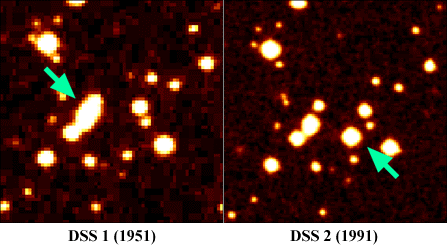Home Page Updated on May 3, 2003
Large proper motion of GSC 3646-01698March 30, 2003Yoshida, S.; Ohkura, N.; Yamaoka, H. We measured the accurate proper motion of GSC 3646-01698, and revealed it has a large proper motion, 0.5415"/year, though it is not recorded in any catalogs of stars with large proper motion. Figure 1 shows the motin of GSC 3646-01698 between 1951 and 1991. 
Figure 1: DSS 2x2 arcmin images. GSC 3646-01698 is recorded in the Guide Star Catalogue version 1.1 with coordinates of R.A. 23h45m41s.59, Decl. +49o42'35".2 (2000.0) at the epoch of September 9, 1983, and brightness of 14.22 mag. Table 1 shows the astrometry of GSC 3646-01698 from POSS-I and POSS-II plates.
Table 1: Astrometry from POSS-I and POSS-II plates. Table 2 shows the astrometry from the unfiltered CCD images taken by Nobuo Ohkura in 2000 and 2001 with 0.16-m f/3.8 Wright-Schmidt reflector and 500-mm camera lens.
Table 2: Astrometry from Ohkura's images. Based on those 13 measurements, the coordinates of GSC 3646-01698 is expressed by the following formulas. Decl. = +49o42'30".30 - 0".305 x (year - 2000) They compute the coordinates in 1950.0 at 23h45m43s.14, +49o42'45".5 (2000.0), and in 2000.0 at 23h45m40s.83, +49o42'30".3 (2000.0). The proper motion is:
Figure 2 shows the motion of GSC 3646-01698. 
Figure 2: Motion of GSC 3646-01698. GSC 3646-01698 is not recorded in any catalogs of stars with large proper motion. The proper motion is larger than 0.5 arcsec per year, but it is not recorded in the LHS (Luyten Half Second) or NLTT (Not Less Than Two tenths) catalogs. It is as bright as 14 mag, but not recorded in the Lowell Proper Motion Survey catalog, which contains down to 16 mag, neither. Only 14% among stars in the Lowell Proper Motion Survey catalog has larger proper motion than GSC 3646-01698. It was very near by GSC 3646-00796, R.A. 23h45m43s.42, Decl. +49o42'40".6 (2000.0), 13.83 mag, around 1950, and looked blending on POSS-I plates. That is the reason why it is not recorded in any catalogs despite of the large proper motion and brightness.
Appendix:
Acknowledgements: The Digitized Sky Surveys were produced at the Space Telescope Science Institute under U.S. Government grant NAG W-2166. The DSS images are obtained at the Astronomical Image On-line Access Interface (http://dss.mtk.nao.ac.jp/). (Supplement on May 3, 2003) Distance to GSC 3646-01698Here is the photometry of GSC 3646-01698 in some catalogs.
The V magnitude is 14.22 mag, although the GSC 1.1 magnitude is inaccurate and not standard. The K magnitude is 8.940 mag, although the 2MASS Ks magnitude is not standard. Then the color of GSC 3646-01698 is roughly derived as: V-K = 5.28 Using the diagram between absolute magnitude and color index displayed in: Photometric properties of low-mass stars and brown dwarfs the absolute magnitude of GSC 3646-01698 is roughly derived as: Mv = 13 It is almost same as Barnard Star whose absolute magnitude is 13.2 mag. So GSC 3646-01698 should be the same type as Barnard Star, whose spectral type is M5. Barnard Star is 6.0 light year from the earth. The V magnitude is 9.54 mag. The V magnitude of GSC 3646-01698 is 14.22 mag, 4.68 mag fainter than Barnard Star. The ratio of brightness becomes: 2.512 ^ 4.68 = 75 The ratio of distance becomes: 75 ^ 0.5 = 8.6 In conclusion, the distance to GSC 3646-01698 is roughly derived as about 52 light year. | ||||||||||||||||||||||||||||||||||||||||||||||||||||||||||||||||||||||||||||||||||||||||||||||||||||
